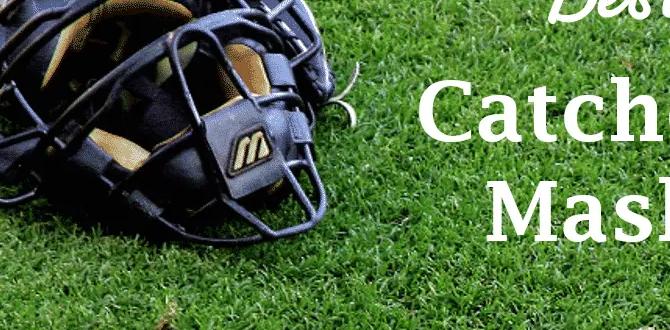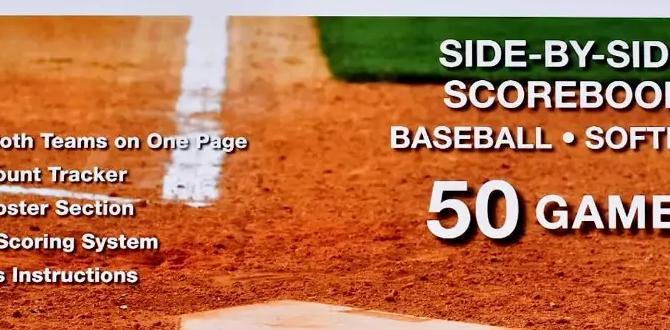Quick Summary: Properly fitting Louisville Slugger catcher shin guards is crucial. Ensure they cover your shin from knee to ankle, don’t pinch, and stay secure during play. A good fit means comfort, protection, and better game performance. We’ll guide you through the simple steps to find your perfect pair.
Hey there, aspiring catchers and super-parents! John P. Miller here from FriskMode. Ever feel like your gear is holding you back instead of protecting you? That’s especially true for catcher’s shin guards. If yours are too loose, they’ll shift, leaving you vulnerable. Too tight, and they’ll be super uncomfortable, making it hard to move. Getting the right fit for your Louisville Slugger shin guards is super important. It’s not just about comfort; it’s about staying safe and playing your best. Don’t worry, we’re going to walk through this together, step by step, so you can find the perfect fit and feel confident behind the plate.
Why the Right Fit Matters for Louisville Slugger Catchers Shin Guards
Think of your shin guards as your first line of defense. When you’re crouched down or blocking a wild pitch, they need to be in the right place, every single time. A pair that fits well does a few key things:
- Maximum Protection: They cover the essential areas of your shins and knees, absorbing impact from foul balls, errant pitches, and collisions.
- Freedom of Movement: When they fit right, you can move freely, pivot, and get up quickly without feeling restricted.
- Comfort for Longer Games: No one wants to deal with rubbing, pinching, or straps digging in for nine innings. A good fit means you can focus on the game.
- Preventing Injury: Ill-fitting gear can actually lead to injuries because it doesn’t provide consistent protection or can cause blisters and chafing.
Louisville Slugger is known for quality equipment, and their shin guards are no exception. But even the best gear won’t perform as it should if it doesn’t fit your body correctly.
Understanding Shin Guard Sizing: Key Measurements
Before you even think about trying on shin guards, you need to know your size. Most manufacturers, including Louisville Slugger, base their sizing on a simple measurement. It’s usually the length from the middle of your kneecap down to the top of your foot (where your shoe meets your shin).
How to Measure for Shin Guards
This is a straightforward process. Grab a friend or family member to help, or do your best to get an accurate measurement yourself.
- Sit Down: Find a chair and sit with your leg bent at a 90-degree angle, just like you would be in a catcher’s crouch.
- Find Your Kneecap: Locate the center of your kneecap. This is your starting point.
- Measure Down: Using a soft measuring tape, measure from the center of your kneecap straight down your shin to where your shoe would typically rest at the top of your foot. Keep the tape measure snug but not tight.
- Write It Down: Record this measurement in inches or centimeters. This is your key number for finding the right size.
Many equipment retailers and the Louisville Slugger website will have sizing charts. You’ll match your measurement to the corresponding size (e.g., Youth Small, Adult Medium, etc.). It’s a good idea to check the chart specific to the model of Louisville Slugger shin guards you’re interested in, as sizes can vary slightly between designs.
The “Try-On” Test: What to Look and Feel For
Once you have your measurement and know your potential size, it’s time to try them on. This is where you really get a feel for the fit. Don’t just slip them on and assume they’re right. You need to go through a few checks.
Step-by-Step Fitting Process
- Put Them On Correctly: Most shin guards have straps that go around the back of your leg. Make sure the padding covers your entire shin, from just below the knee to the top of your foot, without any gaps. The knee cap protector should align with your kneecap.
- Fasten the Straps: Secure the straps. They should be snug enough to keep the guards in place but not uncomfortably tight. You don’t want them digging into your skin.
- Stand Up and Walk Around: Get on your feet. Walk around, jog a little, and do some lunges. Do the shin guards stay put? Do they feel like they’re sliding down or shifting around your leg?
- Get Into a Catcher’s Stance: This is crucial! Crouch down into your blocking stance. How do the guards feel? Are they comfortable in this position? Do they pinch or restrict your movement? Can you easily get up and move?
- Check for Pressure Points: Pay attention to any areas where the guards feel too tight or where straps are creating excessive pressure. This could lead to discomfort or even injury during a game.
- Assess Coverage: Look down. Is the shin completely covered from below the knee to the toe? Good coverage means better protection where you need it most.
- Knee Cap Alignment: Ensure the built-in knee cap or knee protection piece sits directly over your kneecap. It shouldn’t be above or below it.
It’s ideal to wear baseball pants or athletic pants similar to what you’ll wear during games when trying on shin guards. This gives you a more accurate feel for how they’ll fit and perform during actual play.
Common Shin Guard Fitting Issues and How to Solve Them
Even with the best intentions, you might run into a few snags during the fitting process. Here’s how to troubleshoot:
Problem: Guards Slide Down
Solution: This usually means they’re too loose or perhaps the wrong size entirely. Try tightening the straps a bit more. If they still slide, they might be too wide for your legs, or you need a size smaller. Some guards have adjustable strap systems; ensure you’re using them correctly.
Problem: Overly Tight or Pinching Straps
Solution: Loosen the straps! If they’re still pinching, the guard might be too small or too narrow for your calf. Check if the straps are bunched up or twisting. Sometimes, rotating a strap slightly until it lays flat can help. For some models, switching to slightly longer straps (if available) might be an option.
Problem: Gaps in Protection at the Knee or Ankle
Solution: This is a serious issue for protection. The shin guards might be too short for your leg (try a larger size) or not designed to provide that extended coverage. Ensure the knee protector is positioned correctly. Some guards have a removable knee flap that can be adjusted or re-secured to offer better coverage.
Problem: Guards Feel Bulky or Restrictive
Solution: This can sometimes be a trade-off for maximum protection. However, if they feel excessively bulky, they might be too large or simply a model that doesn’t suit your body type. Look for shin guards with a more ergonomic design. Trying on different models from Louisville Slugger or other brands might reveal a sleeker option that still offers good protection.
Remember, feeling comfortable and confident is key. If a pair of shin guards feels “off,” it’s okay to keep looking. The perfect fit is out there!
Louisville Slugger Shin Guard Models: A Quick Look at Features
While the fitting process is universal, different Louisville Slugger models might have unique features that affect how they fit and feel. For example:
- Adjustable Straps: Many modern shin guards, including those from Louisville Slugger, feature adjustable, often elastic, straps with buckles or Velcro. This allows for a customizable fit.
- Moldable Shin Plate: Some higher-end models might have shin plates designed to better conform to your leg shape over time.
- Extended Knee Protection: Some models offer larger, more integrated knee protection, which can affect how they feel around the knee joint.
- Ventilation: While not directly affecting fit, good ventilation can improve comfort, making you feel less restricted and more focused on the game.
When shopping, glance at the product description for any unique features that might impact the fit. For instance, the “Louisville Slugger Pro Gear Catchers Shin Guards” might offer a different fit profile than the “Louisville Slugger Uprising Catcher’s Gear” line, due to differences in padding and construction.
Essential Accessories for Fitting and Use
Beyond the shin guards themselves, a few other items can help ensure a perfect fit and maximum comfort:
What You Might Need:
- Soft Measuring Tape: Essential for getting that accurate measurement.
- Baseball Pants or Athletic Pants: To try on the shin guards with.
- Baseball Socks: Thicker baseball socks can also influence fit, so wear what you plan to use.
- Helper: Someone to help with measurements or to check how the guards look on your legs.
The goal is to simulate game conditions as closely as possible during the fitting process, so wearing your typical baseball attire is a smart move.
FAQs: Your Louisville Slugger Shin Guard Questions Answered
Q1: How do I know if my shin guards are too big?
A1: If there are large gaps at the top or bottom, if they slide down your leg no matter how tight the straps are, or if they feel generally cumbersome and restrict your movement, they are likely too big.
Q2: Can I use shin guards that fit too loosely?
A2: It’s not recommended. Loose shin guards can shift during play, leaving your shins and knees exposed to impact. They can also cause chafing and discomfort, distracting you from the game.
Q3: Should my shin guards extend all the way to my cleats?
A3: The primary goal is coverage from below the kneecap to the top of your foot, where your shoe begins. They don’t need to extend down your cleats, but they should protect the entire exposed shin area.
Q4: How often should I check the fit of my shin guards?
A4: It’s a good idea to check the fit at the beginning of each season. Also, if you notice any slipping or discomfort during play, re-evaluate the fit and strap adjustments.
Q5: Are there different types of shin guards besides standard baseball catcher ones?
A5: Yes! For baseball, you have specific catcher shin guards designed for the rigors of the position. You also have different styles within catcher gear. For other sports, padding might be different. Always use equipment designed for its intended sport.
Q6: What’s the difference between youth and adult shin guard sizing?
A6: Youth sizes are generally shorter and narrower to fit younger players. Adult sizes are longer and wider. Always refer to the specific size chart provided by Louisville Slugger for accurate conversions.
Q7: Can I adjust worn-out straps on my Louisville Slugger shin guards?
A7: Sometimes, it’s possible to replace or repair straps, especially with Velcro. If the padding or main structural components are worn, it might be time to consider a new pair. Check with the manufacturer or a reputable sporting goods store for repair options.
Maintaining Your Louisville Slugger Shin Guards
To ensure your Louisville Slugger shin guards continue to fit well and provide protection, proper care is important. After each use, wipe them down to remove sweat and dirt. Allow them to air dry completely before storing them. Avoid leaving them in extreme heat (like a car trunk on a hot day), as this can degrade the materials and affect their performance over time. Regularly check the straps and buckles for wear and tear. For more detailed care instructions, you can often find helpful information on the official Louisville Slugger website or within the product manual.
Conclusion: Play with Confidence
So there you have it! Fitting Louisville Slugger catcher shin guards isn’t complicated, but it does require a little attention to detail. By taking accurate measurements, performing the thorough try-on test, and understanding how to address common fitting issues, you’ll be well on your way to finding that perfect pair. Remember, properly fitting gear is more than just comfort; it’s about ensuring you have the reliable protection you need to focus on what matters most: playing the game and improving your skills. With the right fit, you can step behind the plate with confidence, knowing your Louisville Slugger gear has your back… and your shins!




